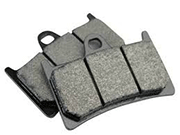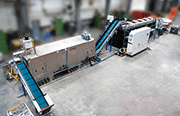E-Archive
Good Vibrations
in Vol. 20 - January Issue - Year 2019
Working Hand in Hand – How Integrated Mass Finishing And Industrial Cleaning Processes Can Streamline Production And Save Costs

Picture 1: Use of separate cleaning and mf compounds requires a drying cycle after washing

Picture 2: One common cleaning/mf compound eliminates the costly drying cycle!

Picture 3: The surface of stamped brake pad carriers must be carefully prepared for the subsequent gluing-on of the actual pads

Picture 4: Drum washer (foreground) directly linked to linear, continuous flow vibrator (background)

Picture 5: Washing, mass finishing and transferring the finished parts into waiting part bins take place fully automatically with minimal operator intervention

Picture 6: Spray washing machine for de-oiling directly linked with blanking and forming press and mass finishing machine
Mass finishing is a truly all-round, multi-purpose surface finishing technology. It is highly effective for deburring/edge radiusing, surface smoothing or high gloss polishing of all kinds of materials, be it metal, plastic and even wood or ceramic. But mass finishing can do much more: It is equally suitable for de-oiling/degreasing, general surface cleaning and passivation/corrosion protection of metal components. Up to a certain point! In case of large amounts of oil on the work pieces, for example, after stamping/blanking/machining operations, or if extremely strict cleanliness requirements must be met in line with ISO 16232, the work pieces must undergo a cleaning process in dedicated industrial washing machines.
While up to now, mass finishing and industrial cleaning have mostly been separate operations, frequently taking place in different departments, it has proven highly beneficial to combine the two into one integrated, fully automated process. This not only simplifies manufacturing logistics, but also helps reduce overall investment expenditures and results in significant savings of operational costs.
Clean work pieces ensure high
product quality!
Practically all industrial manufacturing processes require clean work piece surfaces to ensure the desired high quality of the end products. Cleaning is essential to reduce friction in such diverse components as bearings, gears, turbo chargers, dosing pumps, etc. It is equally important to remove oil, grease and dirt particles from components that must be glued together or coated. In many cases cleaning is necessary to prevent blockages in narrow channels, e.g. the injection nozzles of fuel injection pumps. And it is an indispensable operation for making sure that the circuits on circuit boards, used in thousands of products, do not short out.
When mass finishing reaches its limits
Besides its deburring, surface smoothing and polishing capabilities, mass finishing is also a great method for de-oiling and general surface cleaning of a wide variety of components from such diverse industries as automotive, aerospace, medical engineering, equipment manufacturing, etc. And for most applications, the degree of cleanliness of mass finished work pieces is fully adequate. For example, mass finishing can deal with a certain amount of oil or coolant on stamped and machined work pieces without jeopardizing the deburring goal. Likewise, most orthopedic implants like knee femorals do not have to undergo an additional cleaning stage after they received a mirror polish in a drag finisher.
However, in situations where larger amounts of oil are carried into a mass finishing process, the finishing results might become inadequate, and the process itself would become extremely expensive or even collapse. In such cases it is advisable to wash the parts beforehand. Also, whenever an application demands minimal residual dirt on the finished work pieces, expressed in maximum particle size and particle quantity (per ISO 16232), a post mass finishing cleaning cycle in an industrial washing machine will be required. In other words: for critical work pieces, a cleaning stage might be required prior to as well as after mass finishing.
Fully automatic, combined washing and mass finishing operations for better results and lower costs
Ever more stringent quality demands and the need to remain cost-competitive have encouraged manufacturers to look into combining their washing and mass finishing operations into one single, fully automated process. And there are now already numerous examples of highly successful combined operations.
Of course, there was not only the issue of having to match quite diverse pieces of equipment, but combining them also required an intensive look at the chemical side of the two processes, specifically the respective cleaning and mass finishing compounds. This was especially critical in the case of extremely oily work pieces.
One common cleaning and mass finishing compound eliminates a costly drying cycle
In applications having to deal with oily parts, the dedicated cleaning compounds used for the de-oiling process in industrial washing machines might not be compatible with the compounds used for the mass finishing operation. A carryover of the cleaning compounds from the washing machine into the mass finishing equipment can have disastrous consequences. To prevent this problem, the work pieces coming from the washing machine must usually undergo an intensive drying stage before they can be fed into the mass finishing machine (Picture 1).
The development of combined compounds, which are equally effective for the de-oiling as well as the subsequent mass finishing phase, completely eliminated this problem. Carry-over of compound from the washing machine is no longer a problem but rather welcome, as it is not impeding but supporting the mass finishing process. This simple trick not only helps reduce the overall compound consumption but also does away with the costly post-wash drying operation resulting in substantial savings in capital expenditures, energy consumption as well as overall compound usage. Moreover, it also helps with warehousing by having to stock only one compound (Picture 2).
Some examples of integrated
washing/mass finishing solutions
(1) Fully automatic in-line stamping, washing and mass finishing for brake pad carriers
The task: The surface of brake pad carriers coming from a stamping line must be washed (de-oiled), deburred and textured in a fully automatic process for the subsequent gluing of the brake pads to the carrier plates (Picture 3).
The solution: The work pieces coming from the press are automatically transported into a continuous drum washing machine. The partially perforated drum is equipped with transport flights. In an initial de-oiling step, the carrier plates are immersed into the cleaning liquid in the non-perforated drum section, followed by a spray wash cycle in the perforated drum section and a rinse cycle (Picture 4).
The de-oiled and rinsed parts are then directly passed through a linear, continuous flow vibrator for deburring and surface texturing and a vibratory drier from where they are fully automatically transferred into waiting part bins (Picture 5).
Since the washing and mass finishing operations are using one common compound, the normally required post-wash drying stage is eliminated, resulting in substantial cost savings.
Manual operator intervention is limited to changing out the part bins every few hours.
(2) Integrated washing (de-oiling), mass finishing and fine cleaning line for continuous processing of clutch carriers
The task: De-oiling, deburring and fine cleaning of press formed clutch carriers covered with oil. The cleanliness requirements for the finished work pieces are very strict: No metallic and dirt particles > 600 μ, residual dirt per part = max 1.5 mg.
The solution: The work pieces are automatically transferred from the blanking and forming press into the belt washing machine where they undergo an intensive 2-stage spray-wash and blow-off operation (Picture 6).
The de-oiled parts are then directly passed through a linear, continuous flow vibrator for deburring and light edge radiusing.
To ensure that the cleanliness specs are fully met, the mass finished parts undergo a fine cleaning and passivation operation in a second belt washing machine.
All three processes – de-oiling, mass finishing and fine cleaning – use one common compound, which allows eliminating the drying stage prior to mass finishing.
What to expect for the future
Zero defect requirements in automotive, aerospace, equipment building, etc., will most likely cause the cleanliness requirements for critical work pieces to become even stricter in the future. These tougher requirements can only be met by intelligent, cost-saving surface-finishing solutions. Combined, fully automatic washing & mass finishing systems will no doubt play a key role in these efforts.
Good Vibrations
by Eugen Holzknecht , Contributing Editor MFN
andRösler Oberflächentechnik GmbH
E-mail: holzknecht.usa@gmail.com




























